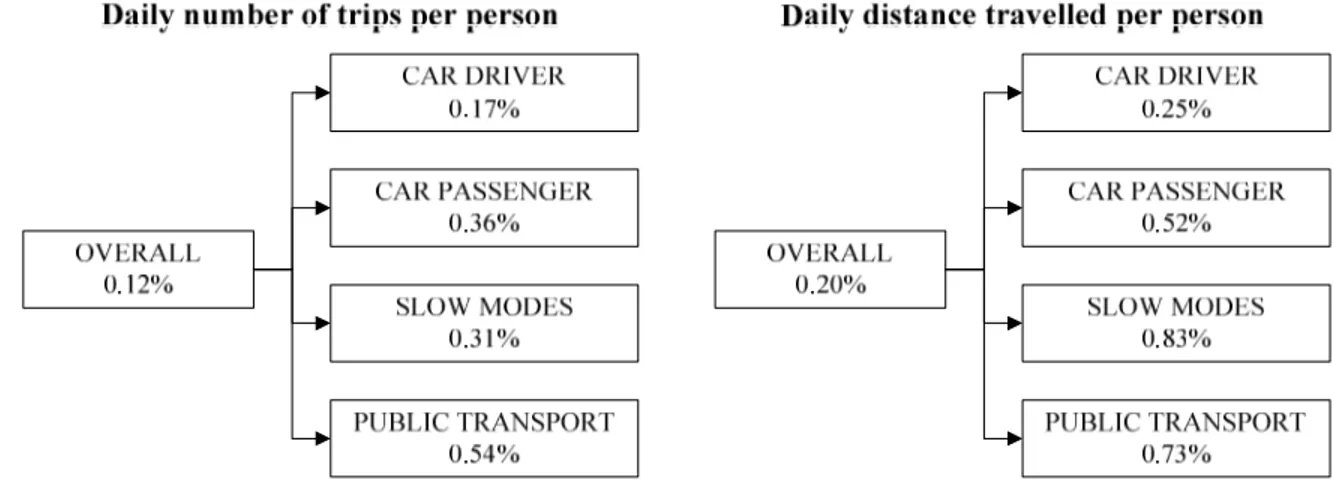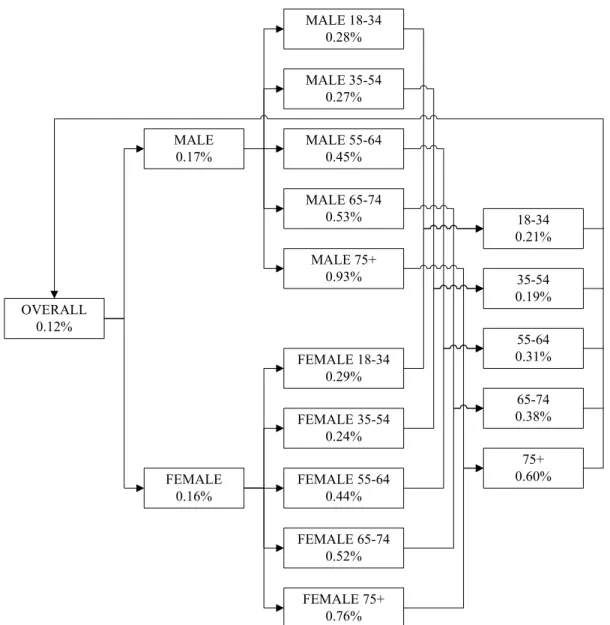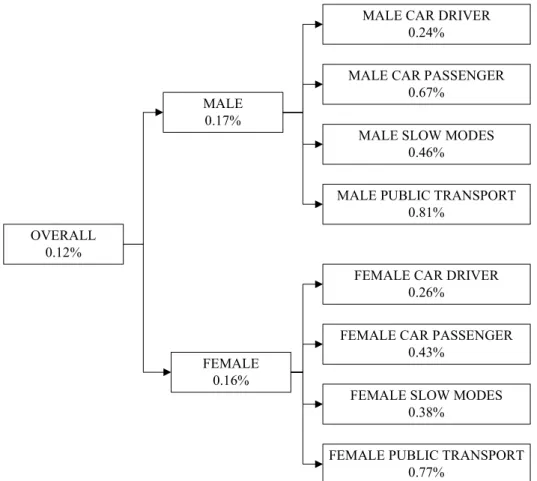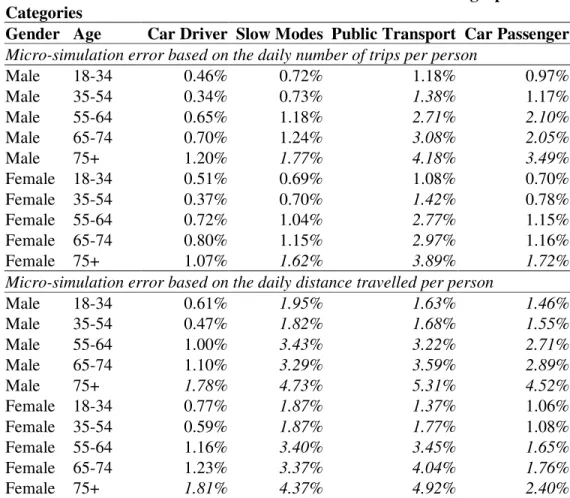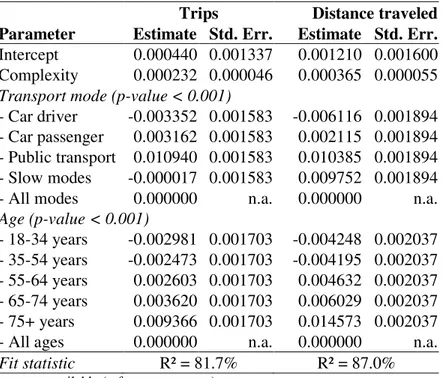1
ASSESSMENT OF THE EFFECT OF MICRO-SIMULATION 2
ERROR ON KEY TRAVEL INDICES: 3
EVIDENCE FROM THE ACTIVITY-BASED MODEL FEATHERS 4
5 6
Mario Cools*, Bruno Kochan, Tom Bellemans, Davy Janssens, and Geert Wets 7
Transportation Research Institute 8 Hasselt University 9 Wetenschapspark 5, bus 6 10 BE-3590 Diepenbeek 11 Belgium 12 Fax.: +32(0)11 26 91 99 13 14 15 Mario Cools 16 Tel.: +32(0)11 26 91 31 17 Email: mario.cools@uhasselt.be 18 19 Bruno Kochan 20 Tel.: +32(0)11 26 91 47 21 Email: bruno.kochan@uhasselt.be 22 23 Tom Bellemans 24 Tel.: +32(0)11 26 91 27 25 Email: tom.bellemans@uhasselt.be 26 27 Davy Janssens 28 Tel.: +32(0)11 26 91 28 29 Email: davy.janssens@uhasselt.be 30 31 Geert Wets 32 Tel.: +32(0)11 26 91 58 33 Email: geert.wets@uhasselt.be 34 35 36 37 * Corresponding author 38 39 40 Number of words = 3862 41 Number of Figures = 5 42 Number of Tables = 2 43
Words counted: 3862+ 7*250 = 5612 words 44
45
Paper submitted: November 14, 2010 46
ABSTRACT 1
2
Current transportation models often do not explicitly address the degree of uncertainty in travel 3
forecasts. Of particular interest in activity-based travel demand models is the model uncertainty 4
that is caused by the statistical distributions of random components, i.e. micro-simulation error. 5
Therefore, the main objective of this paper is to assess the impact of micro-simulation error on 6
two key travel indices, namely the average daily number of trips per person and the average 7
daily distance traveled per person. The effect of micro-simulation error will be investigated by 8
running the activity-based modeling framework FEATHERS 200 times using the same 10% 9
fraction of the population. Results show that micro-simulation errors are limited especially when 10
disaggregation is limited to two levels. Notwithstanding, results indicate that for more elaborate 11
analyses a 10% fraction might not be sufficient. The size of micro-simulation error increases 12
along with complexity. Moreover, more commonly used transport modes such as using the car as 13
driver have a lower error rate. Further research should investigate the impact of the population 14
fraction on the micro-simulation error rates. Besides, one could also investigate other aspects 15
(e.g. the number of activities) involved in the activity-scheduling process. 16
17 18
1 BACKGROUND 1
2
Rising concerns over increasingly intolerable externalities have generated particular interest in 3
how transport planning policies might at least moderate the well-known negative effects of 4
transport and support the principles of sustainable development. This has lead to the 5
development of models which are both used to make long term predictions and to account for an 6
explicit management of travel demand (e.g. road pricing), which objective is to alter travel 7
behavior without necessarily embarking on large-scale infrastructure expansion. 8
The relevance of using travel demand models for this purpose is reflected by the 9
multitude of European Research projects in different countries (e.g. Four Futures of Europe (1), 10
Mobility 2030: Meeting the Challenges to Sustainability (2), TransVisions (3)). In these projects, 11
projections for the future are often done by means of rather straightforward assumptions: all or 12
most future trends are translated into changes in either travel time and transport costs and these 13
variables are subsequently used to estimate mode outcomes (e.g. The TREMOVE model (4)). 14
Therefore, the need of adopting more behaviorally sound models, that do not assess the 15
anticipated changes in behavior by means of a simple transformation, is high. Activity-based 16
models are implemented within a micro-simulation environment and they implement the more 17
behaviorally sound environment by means of individual decision rules about activities and about 18
the way they are dispersed in space and time. As such, they also provide a theoretically and 19
conceptually more sound framework for forecasting travel behavior in comparison with more 20
traditional methods (5, 6). 21
Current models often do not explicitly address the degree of uncertainty in travel 22
forecasts. Since transportation models are used to predict the likely impacts of various policy 23
measures such as congestion charging and new transport infrastructure, it is imminent for 24
decision-making to have an estimate not only of the most likely outcome, but also to know the 25
possible range and variability of future transport predictions and their corresponding 26
probabilities (7). After all, estimates of for instance the financial viability of infrastructure 27
projects are highly dependent on the accuracy of travel demand forecasts (8). 28
Consider the following example that illustrates the significance of accuracy in forecasts 29
to the effective allocation of funds: Bangkok’s Skytrain (costing about 2 billion US dollars) was 30
hugely over-dimensioned because the passenger forecast was 2.5 times higher than the actual 31
ridership. As a result, station platforms are too long for the shortened trains that now operate the 32
system, a large number of trains are superfluous, terminals are to large, etc (9). Moreover, in a 33
more elaborate study of 210 projects in 14 nations with a combined cost of $59 billion, in 9 out 34
of 10 transit projects, transit ridership was overestimated by an average of 106%, and half of all 35
roadway projects had prediction errors of more than 20% (10). These errors can be attributed to 36
many causes, from cynical interpretations of models to achieve political aims of leveraging 37
federal investment in desired projects, to uncertainty in model assumptions and errors in model 38
specifications (11). 39
In essence, uncertainty in model results can be divided into two components; input 40
uncertainty and model uncertainty (12). Input uncertainty expresses the fact that future values of 41
the exogenous variables are unknown. Model uncertainty is caused by two elements (7), namely 42
by specification errors (omitted variables, inappropriate assumptions on functional form and 43
statistical distributions for random components), and errors due to the use of parameter estimates 44
instead of the true values (the model is estimated on a sample of the population only). Of 45
particular interest in activity-based travel demand models is the model uncertainty that is caused 46
by micro-simulation, namely the fact that the results are stochastic, meaning that the forecast 1
changes each time the seeds to the random number generators used in the simulation change 2
(13). Therefore, the main objective of this paper is to assess the impact of micro-simulation error 3
on two key travel indices, namely the average daily number of trips per person and the average 4
daily distance traveled per person The effect of micro-simulation error will be investigated by 5
means of the activity-based modeling framework FEATHERS (14). In Section 2, the set-up of 6
the experiment will be described in more detail. Afterwards, factors that contribute to the error 7
rates will be highlighted in Section 3 and discussed in Section 4. Finally, the main conclusions 8
are recapitalized in Section 5. 9
10
2 EXPERIMENT 11
12
As outlined in the introduction, the impact of micro-simulation on key travel indices will be 13
investigated using the FEATHERS activity-based modeling framework. In essence, FEATHERS 14
is a rule- and agent-based micro-simulation model developed for Flanders, the Dutch speaking 15
and northern part of Belgium (14). The core activity scheduler of the model is based on the 16
scheduling model that is present in the ALBATROSS model (15-16) which was developed for 17
the Netherlands. 18
For the experiment, a 10% fraction of the population (corresponding to 616,160 persons) 19
will be simulated. Although Castiglione et al. (17) used the full population of households to 20
systematically analyze the impact of (micro-)simulation error for the San Francisco model, 21
Walker (13) indicated that this is not always necessary, and computation times could be saved 22
using only a fraction of the whole population. Moreover, in most applications it suffices to 23
synthesize only a fraction of the total population. Arentze and Timmermans (18) indicate that a 24
fraction of 10% would suffice to for instance reveal the mobility effects on a national level of 25
even a small increase in fuel price. 26
To estimate the error due to (micro-)simulation, the FEATHERS model will be run 200 27
times. For all these 200 runs the same 10% fraction of the population will be taken to ensure that 28
the variability in the model outputs is due to the model uncertainty and not due to the selection 29
of a different sample of households. For each of these runs, the most prevalent travel indices in 30
Flemish policy practice (see e.g. the reports on the Flemish ‘national’ household travel surveys 31
2008 (19) and 2009 (20)) will be computed, namely the average daily number of trips per person 32
and the average daily distance traveled per person. These travel indices are computed for the 33
entire sample, as well as for particular target segments. A subdivision of these travel indices will 34
be made based on one particular travel facet, namely mode choice, as well as for the socio-35
demographic variables age and gender. In addition, the cross-tabulations of the travel facet and 36
socio-demographic variables are also computed. This way, one of the most important gains of 37
micro-simulation, namely the preservation of the entire richness of the population throughout the 38
modeling process, is explicitly tested. 39
Based on the 200 runs the averages and standard deviations of the number of trips and 40
distances are calculated. In this study, the micro-simulation error rate is defined as the standard 41
deviation divided by the mean, which yields the relative standard deviation when compared to its 42
mean. A value of 1.27% of this error rate is considered to be an acceptable barrier as in this case, 43
as the corresponding 95% confidence bounds define a range of 5% deviation (1.27% × z0.025 × 2 44
= 1.27% × 1.96 × 2), given the fact that the key indices (number of trips and total trip distance) 45
are normally distributed. The latter hypothesis will be tested using the Shapiro-Wilk test (21), 1
the Cramer-von Mises test (22) and the Anderson-Darling test (23). 2
In addition to the descriptive segmentation of the micro-simulation error rate, a linear 3
regression model will be estimated to explain the variances in the micro-simulation errors. The 4
dependent variable in this model will be micro-simulation error rate for a particular setting (e.g. 5
the overall mean, the mean for males, etc). The explanatory variables that are going to be used 6
for the analysis are the complexity, which is defined as the number of cross-tabulations of the 7
error rate (e.g. when the combined effect of transport mode and age is considered the complexity 8
is 20 (4 transport modes × 5 age categories), transport mode (all modes (reference category), car 9
as driver, car as passenger, slow modes, and public transport), gender (all gender (reference 10
category), males, females), and age (all age classes (reference category), 18-34 years, 35-54 11
years, 55-64 years, 65-74 years, and 75+ years). Note that the different categories of the 12
transport mode and socio-demographic uniquely match the categories defined within the 13 FEATHERS framework (14). 14 15 3 RESULTS 16 17
Before elaborating on the segmentation and analysis of the micro-simulation error, it is 18
important that, as assumed, the mean number of trips and distance travelled tabulated for 19
different segments in each run are normally distributed according to the different normality tests. 20
Consequently, the 1.27% error bound indicating an acceptable amount of micro-simulation error 21
is defensible. 22
23
3.1 Identification of Influencing Factors 24
25
In order to identify potential influencing factors, a subdivision of the micro-simulation error for 26
both travel indices (number of trips, total trip distance) is made based on mode choice, socio-27
demographic variables and cross-effects. 28
29
3.1.1 Mode Choice
30 31
Investigation of Figure 1 reveals that the overall error is higher for the daily distance traveled per 32
person than for the daily number of trips. This can be accounted for by the fact that the rule-33
based activity-scheduler within the FEATHERS framework schedules the type of activities in an 34
earlier step than the activity locations, the latter step dependent upon the earlier steps in the 35
activity-scheduler. For a detailed description of the sequential steps in the activity-scheduler the 36
reader is referred to Arentze et al. (24). 37
Besides, one could note that the micro-simulation error rate is smaller for more 38
commonly used transport modes, both for the number of trips and total distance travelled. The 39
ordering of the magnitude of the micro-simulation error rate appears to be reciprocal to the share 40
the transport mode has in respectively the number of trips and distance traveled. Nonetheless, all 41
error relates are acceptable and only marginally change the estimates of the key indices. 42
43 44 45 46
1
FIGURE 1 Micro-simulation error for different transport modes 2
3
3.1.2 Socio-Demographical Variables
4 5
Next to the travel facet mode choice, it is also interesting to look at the potential impact of socio-6
demographical variables. Figures 2 and 3 provide insight in the effect of the variables age and 7
gender on the micro-simulation error rate of respectively the number of trips and distance 8
traveled. Gender appears to have only a limited effect on the error rates, whereas the error rates 9
differ apparently more between different age categories. At least two explanations can be 10
formulated to explain the dissimilarities in error rates between different age groups. The first 11
explanation is the fact that the first two age classes (18-34 years and 35-54 years) involve a 12
larger population than age classes (55-64 years and 65-74 years), which on their turn involve a 13
larger population than the oldest age category. A second reason is the fact that this age class 14
involves way more people that do not travel at all. Consequently, the choice facet of engaging in 15
out-of-home activities or not does have a larger effect of this group, potentially increasing the 16
micro-simulation error rate. Overall, the error due to micro-simulation is acceptable, even for the 17
cross-tabulation of both age and gender, with exception of the combined age and gender effect 18
for the oldest age category with respect to the daily distance traveled. The latter categories 19
(males 75+ and fames 75+) marginally exceed the 1.27 error bound. 20
OVERALL 0.12% MALE 0.17% FEMALE 0.16% MALE 18-34 0.28% MALE 35-54 0.27% MALE 55-64 0.45% MALE 65-74 0.53% MALE 75+ 0.93% FEMALE 18-34 0.29% FEMALE 35-54 0.24% FEMALE 55-64 0.44% FEMALE 65-74 0.52% FEMALE 75+ 0.76% 18-34 0.21% 35-54 0.19% 55-64 0.31% 65-74 0.38% 75+ 0.60% 1
FIGURE 2 Micro-simulation error for different socio-demographic categories based on 2
the daily number of trips per person. 3
4 5
OVERALL 0.20% MALE 0.27% FEMALE 0.29% MALE 18-34 0.47% MALE 35-54 0.41% MALE 55-64 0.79% MALE 65-74 0.91% MALE 75+ 1.56% FEMALE 18-34 0.52% FEMALE 35-54 0.44% FEMALE 55-64 0.92% FEMALE 65-74 0.93% FEMALE 75+ 1.35% 18-34 0.38% 35-54 0.30% 55-64 0.59% 65-74 0.67% 75+ 0.96% 1
FIGURE 3 Micro-simulation error for different socio-demographic categories based on 2
the daily distance travelled per person. 3
4
3.1.3 Combined Effects
5 6
A final segmentation could be made based on the combined effect of socio-demographic 7
variables and mode choice. Figures 4 and 5 display the cross-tabulations of gender and mode 8
choice, but obviously also other cross-tabulations (i.e. the two-way cross-tabulation age and 9
mode choice, and three-way cross-tabulation age, gender and mode choice) can be made. From 10
both figures it becomes apparent that error-rates increase as complexity increases. Three-way 11
tabulations (Table 1) reveal that some micro-simulation error rates, especially those on trip 12
distance often exceed the 1.27% boundary. This suggests that for detailed disaggregate analyses 13
of travel behavior, running the full population sample rather than a fraction might be necessary. 14
OVERALL 0.12% MALE 0.17% FEMALE 0.16%
MALE CAR DRIVER 0.24%
MALE CAR PASSENGER 0.67%
MALE SLOW MODES 0.46%
MALE PUBLIC TRANSPORT 0.81%
FEMALE CAR DRIVER 0.26%
FEMALE CAR PASSENGER 0.43%
FEMALE SLOW MODES 0.38%
FEMALE PUBLIC TRANSPORT 0.77%
1
FIGURE 4 Micro-simulation error for combined gender and mode choice categories based 2
on the daily number of trips per person. 3
4 5 6
OVERALL 0.20% MALE 0.27% FEMALE 0.29%
MALE CAR DRIVER 0.33%
MALE CAR PASSENGER 0.98%
MALE SLOW MODES 1.22%
MALE PUBLIC TRANSPORT 1.08%
FEMALE CAR DRIVER 0.39%
FEMALE CAR PASSENGER 0.64%
FEMALE SLOW MODES 1.04%
FEMALE PUBLIC TRANSPORT 0.99%
1
FIGURE 5 Micro-simulation error for combined gender and mode choice categories based 2
on the daily distance travelled per person. 3 4 5 6 7 8
TABLE 1 Micro-Simulation Error for Combined Socio-Demographic and Mode Choice 1
Categories 2
Gender Age Car Driver Slow Modes Public Transport Car Passenger
Micro-simulation error based on the daily number of trips per person
Male 18-34 0.46% 0.72% 1.18% 0.97% Male 35-54 0.34% 0.73% 1.38% 1.17% Male 55-64 0.65% 1.18% 2.71% 2.10% Male 65-74 0.70% 1.24% 3.08% 2.05% Male 75+ 1.20% 1.77% 4.18% 3.49% Female 18-34 0.51% 0.69% 1.08% 0.70% Female 35-54 0.37% 0.70% 1.42% 0.78% Female 55-64 0.72% 1.04% 2.77% 1.15% Female 65-74 0.80% 1.15% 2.97% 1.16% Female 75+ 1.07% 1.62% 3.89% 1.72%
Micro-simulation error based on the daily distance travelled per person
Male 18-34 0.61% 1.95% 1.63% 1.46% Male 35-54 0.47% 1.82% 1.68% 1.55% Male 55-64 1.00% 3.43% 3.22% 2.71% Male 65-74 1.10% 3.29% 3.59% 2.89% Male 75+ 1.78% 4.73% 5.31% 4.52% Female 18-34 0.77% 1.87% 1.37% 1.06% Female 35-54 0.59% 1.87% 1.77% 1.08% Female 55-64 1.16% 3.40% 3.45% 1.65% Female 65-74 1.23% 3.37% 4.04% 1.76% Female 75+ 1.81% 4.37% 4.92% 2.40%
Values in italic pinpoint micro-simulation error rates that exceed 1.27%. 3
4
3.2 Model Results 5
6
Next to the subdivision of the micro-simulation error rate according to transport mode, age and 7
gender, a linear regression model is estimated to explain the variances in the micro-simulation 8
error rates. Gender had no significant impact on the micro-simulation error rates, neither on the 9
error rates of the number of trips, nor on the error rates of the distance traveled, and was 10
therefore not remained in the final models. The parameter estimates of these models are 11
displayed in Table 2. Both models predict more than 80% of the variability in the error rates. 12
From Table 2 one could note that, as expected, the micro-simulation error increases along 13
with the complexity (the level of disaggregation, defined as the number of cross-tabulations of 14
the error-rate). In addition, error rates for the most common transport mode (car driver) are 15
significantly lower than for the other transport modes (the estimate of car driver is significantly 16
lower both in the model predicting the micro-simulation error in terms of the number of trips and 17
in the model predicting the micro-simulation error in terms of the distance traveled). Finally, age 18
has an increasing effect of the error rates, the older the age category considered, the higher the 19
error rate. This supports the thesis the variability in older age-classes is higher due to the higher 20
share of non-travelers and more essential more non-workers. 21
TABLE 2 Parameter Estimates of Linear Regression Model Predicting the Micro-1
Simulation Error Rate 2
Trips Distance traveled Parameter Estimate Std. Err. Estimate Std. Err. Intercept 0.000440 0.001337 0.001210 0.001600 Complexity 0.000232 0.000046 0.000365 0.000055
Transport mode (p-value < 0.001)
- Car driver -0.003352 0.001583 -0.006116 0.001894 - Car passenger 0.003162 0.001583 0.002115 0.001894 - Public transport 0.010940 0.001583 0.010385 0.001894 - Slow modes -0.000017 0.001583 0.009752 0.001894 - All modes 0.000000 n.a. 0.000000 n.a.
Age (p-value < 0.001) - 18-34 years -0.002981 0.001703 -0.004248 0.002037 - 35-54 years -0.002473 0.001703 -0.004195 0.002037 - 55-64 years 0.002603 0.001703 0.004632 0.002037 - 65-74 years 0.003620 0.001703 0.006029 0.002037 - 75+ years 0.009366 0.001703 0.014573 0.002037 - All ages 0.000000 n.a. 0.000000 n.a.
Fit statistic R² = 81.7% R² = 87.0%
n.a.: not available (reference category) 3
4
4 DISCUSSION 5
6
To conduct the experiment the FEATHERS activity-based model was run 200 times. This 7
number should be enough to carefully assess the effect of micro-simulation. Although literature 8
that systemically investigates micro-simulation error of activity-based travel demand models is 9
limited, the largest number of runs retrieved was 100 (17). Therefore it was concluded that 10
running the FEATHERS activity-based model 200 times was certainly sufficient to draw valid 11
conclusions concerning micro-simulation error. 12
The results support the thesis formulated by Arentze and Timmermans (18) that a 13
fraction of 10% suffices for revealing the mobility effects on a national level of policy measures 14
such as increases in travel costs (e.g. due to increasing fuel prices or road pricing), at least for 15
activity-based models with a similar activity scheduler as the FEATHERS and ALBATROSS 16
models. 17
It is important to stress that the sample 10% fraction was used in each of the 200 runs. 18
Moreover, all required attributes for the population were either available from the census (the 19
vast majority of socio-demographic and travel-related), or simulated before hand. Therefore, the 20
resulting micro-simulation errors reported in this paper are purely due to the variation caused by 21
the activity-scheduler in the FEATHERS framework. 22
Another point that needs attention is the fact that the impact of model uncertainty, i.e. 23
micro-simulation error is investigated on two specific travel indices (the average daily number of 24
trips per person and the average daily distance traveled per person). The applied methodology 25
can be applied to other more complex travel indicators without complicating the simulation or 26
analysis of results. 27
5 CONCLUSIONS 1
2
In this paper, model uncertainty caused by the statistical distributions of random components, 3
i.e. micro-simulation error was investigated by means of 200 runs of the FEATHERS activity-4
based model using a 10% fraction. Results showed that micro-simulation errors are limited 5
especially when disaggregation is limited to two levels. Notwithstanding, results indicated that 6
for more elaborate analyses a 10% fraction might not be sufficient. A well-considered definition 7
of the various categories of explanatory variables used in the activity-based model is therefore 8
needed to ensure that more elaborate analysis still yield acceptable results for various cross-9
tabulations. The size of micro-simulation error increases along with complexity, as could be 10
expected. Moreover, more commonly used transport modes such as using the car as driver have 11
not surprisingly a lower error rate. 12
Further research should investigate the impact of the population fraction on the micro-13
simulation error rates. Although computationally burdensome, expanding the experiment for 14
different sampling rates might provide a solid base for selecting the required fraction. After all, 15
these would allow the analysis to balance computational complexity and micro-simulation error. 16
The results presented in this paper contribute significantly as they provide support for the thesis 17
of Arentze and Timmermans (18) that the model results using a 10% fraction will be certainly 18
stable enough for strategic decision makings. Concerning more detailed analysis, especially for 19
car drivers, accurate model results can be obtained. As reducing car use is often of key interest, 20
the FEATHERS model using this 10% fraction will yield satisfactory results. Besides repeating 21
the experiment for different fraction, one could also investigate other aspects (e.g. the number of 22
activities) involved in the activity-scheduling process. 23
In addition to looking at micro-simulation errors, further research should investigate the 24
input uncertainty present in the model. To pin-point the effect of input uncertainty, this paper 25
already provided the insight to account for the micro-simulation effects that might obfuscate the 26
effects of input uncertainty. 27
28
6 REFERENCES 29
30
(1) de Mooij, R., and P. Tang. Four Futures of Europe. Centraal Planbureau, Den Haag, The 31
Netherlands, 2003. 32
33
(2) World Business Council for Sustainable Development. Mobility 2030: Meeting the 34
Challenges to Sustainability. World Business Council for Sustainable Development
35
(WBCSD), Conches-Geneva, Switzerland, 2004. 36
37
(3) Petersen M. S., R. Enei, C. O. Hansen, E. Larrea, O. Obisco, C. Sessa, P. M. Timms, 38
and A. Ulied. Report on Transport Scenarios with a 20 and 40 year Horizon. Final report. 39
Tetraplan A/S, Copenhagen, Denmark, 2009. 40
41
(4) De Ceuster, G., B. van Herbruggen, O. Ivanova, K. Carlier, A. Martino, and D. Fiorello. 42
TREMOVE 2.52 Final Report. European Commission, Brussels, Belgium, 2007.
43 44
(5) Pendyala, R. M., R. Kitamura, A. Kikuchi, T. Yamamoto, and S. Fujii. 2005. Florida 45
Activity Mobility Simulator Overview and Preliminary Validation Results. In 46
Transportation Research Record: Journal of the Transportation Research Board, No. 1
1921, Transportation Research Board of the National Academies, Washington, D.C., 2005, 2
pp. 123-130. 3
4
(6) Davidson, W., R. Donnelly, P. Vovsha, J. Freedman, S. Ruegg, J. Hicks, J. Castiglione, 5
and R. Picado. Synthesis of first practices and operational research approaches in activity-6
based travel demand modeling. Transportation Research Part A: Policy and Practice, 7
Vol. 41, No. 5, 2007, pp. 464-488. 8
9
(7) de Jong, G., A. Daly, M. Pieters, S. Miller, R. Plasmeijer, and F. Hofman. 2007. 10
Uncertainty in traffic forecasts: literature review and new results for The Netherlands. 11
Transportation, Vol. 34, No. 4, 2007, pp. 375-395. 12
13
(8) Flyvbjerg, B., M. K. S. Holm, and S. L. Buhl., S.L. Inaccuracy in Traffic Forecasts. 14
Transport Reviews, Vol. 26, No. 1, 2006, pp. 1-24. 15
16
(9) Flyvbjerg, B. Measuring inaccuracy in travel demand forecasting: methodological 17
considerations regarding ramp up and sampling. Transportation Research Part A: Policy 18
and Practice, Vol. 39, No. 6, 2005, pp. 522-530. 19
20
(10) Flyvbjerg, B., M. K. S. Holm, and S. L. Buhl. How (In)accurate Are Demand Forecasts in 21
Public Works Projects? The Case of Transportation. Journal of the American Planning 22
Association, Vol. 71, No. 2, 2005, pp. 131-146. 23
24
(11) Sevcíková, H., A. E. Raftery, and P. A. Waddell. Assessing uncertainty in urban 25
simulations using Bayesian melding. Transportation Research Part B: Methodological, 26
Vol. 41, No. 6, 2007, pp. 652-669. 27
28
(12) Hugosson, M. B. Quantifying uncertainties in a national forecasting model. Transportation 29
Research Part A: Policy and Practice, Vol. 39, No. 6, 2005, pp. 531-547. 30
31
(13) Walker, J. Making Household Microsimulation of Travel and Activities Accessible to 32
Planners. In Transportation Research Record: Journal of the Transportation Research 33
Board, No. 1931, Transportation Research Board of the National Academies, Washington,
34
D.C., 2005, pp. 38-48. 35
36
(14) Bellemans, T., D. Janssens, G. Wets, T. Arentze, and H. Timmermans. Implementation 37
Framework and Development Trajectory of Feathers Activity-Based Simulation Platform. 38
Forthcoming in Transportation Research Record: Journal of the Transportation Research 39
Board, Transportation Research Board of the National Academies, Washington, D.C., 40
2010. 41
42
(15) Arentze, T., F. Hofman, H. van Mourik, and H. Timmermans. ALBATROSS: Multiagent, 43
Rule-Based Model of Activity Pattern Decisions. In Transportation Research Record: 44
Journal of the Transportation Research Board, No. 1706, Transportation Research Board
45
of the National Academies, Washington, D.C., 2000, pp. 136-144. 46
1
(16) Arentze, T. A., and H. J. P. Timmermans. A learning-based transportation oriented 2
simulation system. Transportation Research Part B: Methodological, Vol. 38, No. 7, 2004, 3
pp. 613-633. 4
5
(17) Castiglione, J., J. Freedman, and M. Bradley. Systematic Investigation of Variability Due 6
to Random Simulation Error in an Activity-Based Microsimulation Forecasting Model. In 7
Transportation Research Record: Journal of the Transportation Research Board, No. 8
1831, Transportation Research Board of the National Academies, Washington, D.C., 2003, 9
pp. 76–88. 10
11
(18) Arentze, T., and H. Timmermans. ALBATROSS: overview of the model, application and 12
experiences. Paper presented at the Innovations in Travel Modeling 2008 Conference, 13
Portland, Oregon, 2008. 14
15
(19) Moons, E. Onderzoek Verplaatsingsgedrag Vlaanderen 3 (2007-2008): Tabellenrapport. 16
Transportation Research Institute (IMOB), Hasselt University, Diepenbeek, Belgium, 17
2009. 18
19
(20) Cools, M., K. De Clercq, and D. Janssens. Onderzoek Verplaatsingsgedrag Vlaanderen 4.1 20
(2008-2009): Tabellenrapport. Transportation Research Institute (IMOB), Hasselt
21
University, Diepenbeek, Belgium, 2010. 22
23
(21) Shapiro, S. S., and M. B. Wilk. An analysis of variance test for normality (complete 24
samples). Biometrika, Vol. 52, No. 3-4, 1965, pp. 591-611. 25
26
(22) Anderson, T. W. On the Distribution of the Two-Sample Cramer-von Mises Criterion. The 27
Annals of Mathematical Statistics, Vol. 33, No. 3, 1962, pp. 1148-1159. 28
(23) Anderson, T. W., and D. A. Darling. Asymptotic Theory of Certain "Goodness of Fit" 29
Criteria Based on Stochastic Processes. The Annals of Mathematical Statistics, Vol. 23, 30
No. 2, 1952, pp. 193-212. 31
32
(24) Arentze, T., F. Hofman, and H. Timmermans. Reinduction of Albatross Decision Rules 33
with Pooled Activity-Travel Diary Data and an Extended Set of Land Use and Cost-34
Related Condition States. In Transportation Research Record: Journal of the 35
Transportation Research Board, No. 1831, Transportation Research Board of the National
36
Academies, Washington, D.C., 2003, pp. 230-239. 37
38 39
